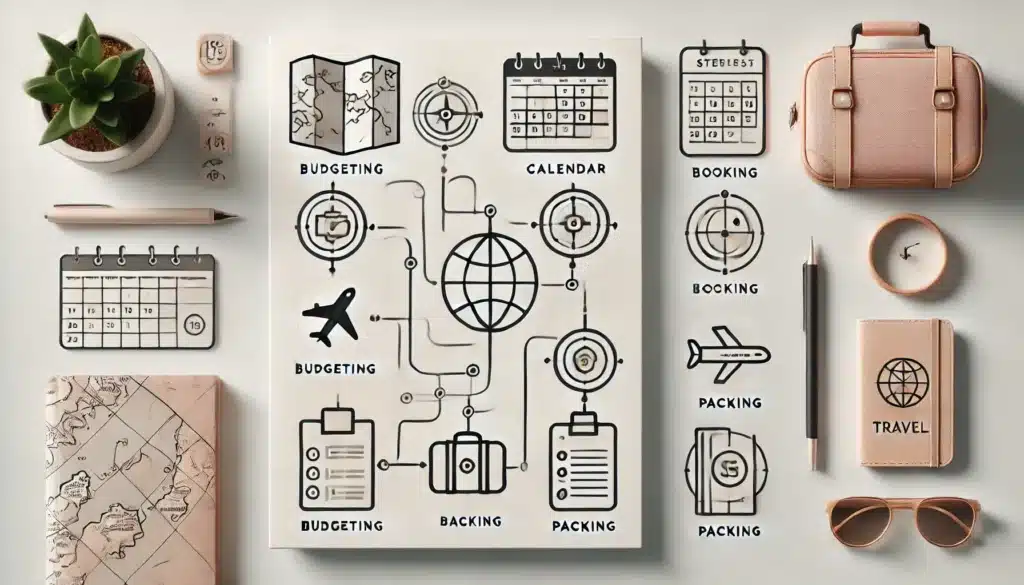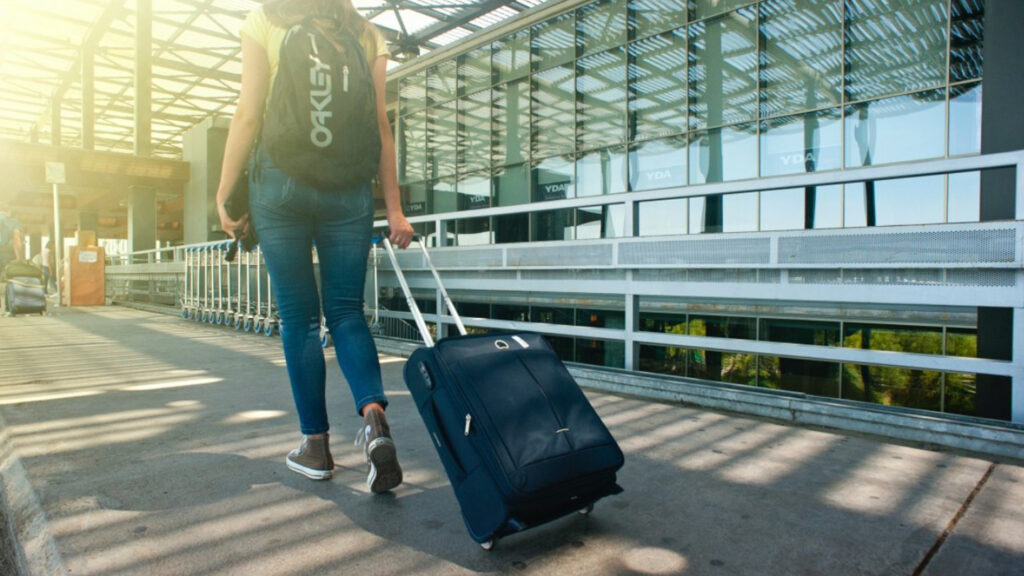Planning a trip can feel like a huge task, right? There’s so much to think about, from picking the perfect destination to figuring out all the little details like where to stay, what to do, and how to get around. That’s why I put together this guide on “How to Plan a Trip in 10 Simple Steps.”
This article breaks it all down so that, instead of feeling overwhelmed, you’ll have a clear, easy plan to follow. It covers everything you need to know to make sure your trip goes smoothly and stays within budget—plus some great tips on getting the best deals and packing smart. Whether you’re planning a quick weekend getaway or a big overseas adventure, this guide is designed to make your travel planning simple and stress-free.
Table of Contents
1. Decide on Your Destination
Begin by asking yourself what type of experience you’re looking for. Are you craving a beachside escape, a historical city adventure, or a hike through the mountains? Consider the time of year and the weather at potential destinations. Make a list of two or three places that excite you, and then research aspects like safety, affordability, language, and any cultural practices. Look up recent traveler reviews and local blogs to get a feel for each place. Narrow down your list until you have your final pick.
2. Set a Realistic Budget
Establishing a budget is key for avoiding overspending. Create a budget that includes flights, accommodation, daily meals, activities, souvenirs, and unexpected costs. Research typical costs in your chosen destination to make your estimates as accurate as possible. Consider hidden expenses like visa fees, airport transfers, and city taxes. Decide if you’ll save on some aspects (like staying in budget hotels or cooking a few meals) to splurge on others (such as unique experiences or fine dining).
3. Pick Your Travel Dates Thoughtfully
Choose dates that work well with your schedule and your destination’s peak seasons. Many popular places are busiest (and most expensive) during holidays and summer. For lower prices and fewer tourists, travel during the shoulder seasons (spring or fall) when the weather is still pleasant. If you have flexibility, use tools like Google Flights’ date grid or Skyscanner’s “Cheapest Month” feature to find the best times to travel affordably. Pro tip: Booking flights on mid-week days can often be cheaper than weekend fares.
More Travel blog
4. Book Flights and Accommodations Early
Once your dates are set, start tracking flight prices using tools like Hopper, which can notify you of drops in airfare prices. For accommodations, think about what kind of lodging fits your travel style and budget. Whether it’s hotels, hostels, vacation rentals, or unique stays like treehouses or houseboats, book early to secure your spot, especially in popular areas. Be sure to read reviews carefully on sites like TripAdvisor or Google Maps for unbiased feedback.
5. Create a Day-by-Day Itinerary
An itinerary can help you make the most of each day without feeling rushed. List out all the attractions, activities, and restaurants you want to visit. Then, group them by neighborhood or theme to reduce travel time. Use Google Maps to calculate walking or transit distances, and set aside time for meals and relaxation. Check if any activities require advance bookings, such as museum tickets, guided tours, or events. For a balanced trip, plan a mix of “must-do” activities and open slots for spontaneous exploration.
6. Arrange Local Transportation Options
Once your itinerary is set, plan how you’ll get around. Check if the city has reliable public transportation (like metros, buses, or trams) and whether there are travel passes available that could save money. For remote locations, research car rentals or look into booking taxis through reputable apps. Many places also offer fun options like bike or scooter rentals, which can be a great way to explore. Make sure to download offline maps if you’ll be in areas with limited internet access.
7. Check Visa, Passport, and Health Requirements
Don’t overlook the paperwork! Research whether your destination requires a visa, how to obtain it, and how long processing will take. Check your passport’s expiration date and ensure you have at least six months’ validity from your return date. For some regions, vaccinations or health checks may be required, so consult your doctor or a travel clinic for any recommended vaccines. Lastly, register your trip with your country’s embassy if you’re traveling abroad for added safety.
8. Invest in Travel Insurance
Travel insurance may feel optional, but it’s worth the peace of mind it provides. Look for plans that cover medical emergencies, trip cancellations, baggage loss, and trip interruptions. Some insurance policies offer specific coverage for adventure activities if you’re planning to do anything risky like scuba diving or skiing. Compare quotes from reputable providers like World Nomads or Allianz and read the fine print to understand what’s included and excluded.
9. Pack Smart with Essentials Only
Packing efficiently is crucial for stress-free travel. Start by checking the weather forecast for your destination and creating a list of essentials tailored to your activities. Pack versatile clothing that you can layer, and limit yourself to one pair of comfortable shoes plus a dressier pair if needed. Include a small first-aid kit, toiletries, and any necessary medications. If you’re bringing electronics, don’t forget chargers, adapters, and a portable power bank. For longer trips, consider packing cubes to keep your luggage organized.
10. Prepare for Departure and Finalize Details
In the days before departure, check off all final preparations. Confirm all reservations, from flights and hotels to any activity bookings. Organize your travel documents in a folder or digital app like TripIt, and set up a notification for check-in reminders. Call your bank to inform them of your travel dates to avoid any issues with your credit or debit cards abroad. Download entertainment for your journey, make copies of your passport and IDs, and double-check that you have cash or credit cards for currency exchange.
Bonus Tips for a Seamless Trip
- Use Travel Apps: Apps like Google Translate, XE Currency, and offline maps can make navigating a foreign country easier.
- Respect Local Customs: Research cultural norms at your destination to avoid unintentional disrespect, such as dress codes or tipping customs.
- Stay Updated on Local News: Check travel advisories for any changes in safety, weather, or entry requirements right before you go.
- Stay Flexible: Things don’t always go as planned, so approach changes with flexibility and a positive mindset for a smoother trip.
Last Things
Following these 10 steps, planning your trip becomes a structured, enjoyable process rather than a stressful scramble. Preparing thoughtfully ensures you’re free to relax, explore, and fully enjoy the adventure that awaits. Now, you’re ready to turn your dream trip into reality—bon voyage!
FAQs How to Plan A Trip
Q: How far in advance should I start planning my trip?
A: For international trips, start 4-6 months in advance; for domestic, 2-3 months is usually enough.
Q: How can I find the best deals on flights?
A: Use comparison sites like Skyscanner and set price alerts; weekdays often offer lower fares.
Q: When is the best time to travel to avoid crowds?
A: The shoulder seasons (spring and fall) typically have fewer tourists and better prices.
Q: Do I need travel insurance, and what does it cover?
A: Yes, it’s recommended. Travel insurance covers medical emergencies, trip cancellations, and lost baggage.
Q: What should I include in my budget?
A: Include flights, accommodation, food, activities, transportation, souvenirs, and a buffer for unexpected costs.
Q: How do I create a balanced itinerary?
A: Prioritize top activities and group nearby sites together; leave some free time for spontaneity.
Q: What should I research before booking accommodations?
A: Check reviews, location, amenities, and cancellation policies to find the best option for your needs.
Q: How do I handle money and payments abroad?
A: Use a mix of local currency, credit cards with no foreign fees, and consider travel cards for easy exchange.
Q: What are the essentials I should pack?
A: Pack versatile clothing, weather-appropriate items, travel documents, chargers, and a small first-aid kit.
Q: How can I prepare for any language barriers?
A: Download Google Translate and learn a few key phrases in the local language for smoother communication.
Q: Is it safe to use public transportation while traveling?
A: Generally, yes. Research the local transit system and avoid isolated areas, especially at night.










Heya i am for the first time here. I found this board and I find
It really useful & it helped me out much. I hope to give something back and aid others
like you aided me.
I’m not that much of a internet reader to be
honest but your blogs really nice, keep it up! I’ll go ahead
and bookmark your site to come back later. All the best
Great goods from you, man. I have understand your stuff previous to and you are
just too excellent. I really like what you’ve acquired
here, certainly like what you are saying and the way in which you say it.
You make it enjoyable and you still take care of to keep it
wise. I can not wait to read much more from you. This is really a wonderful web site.